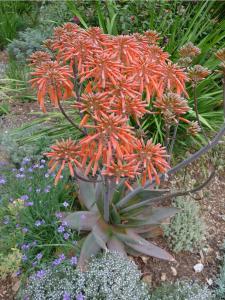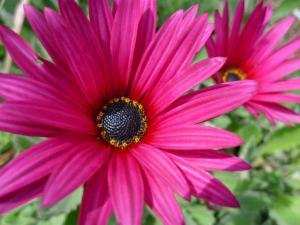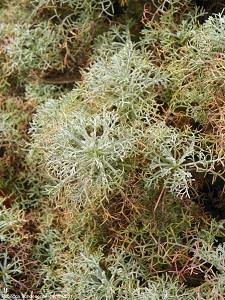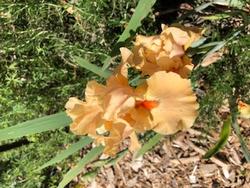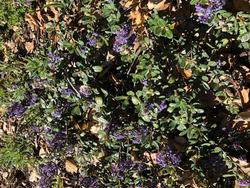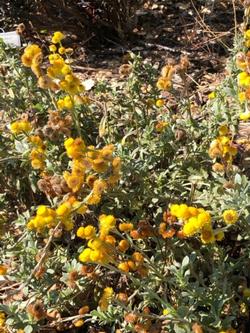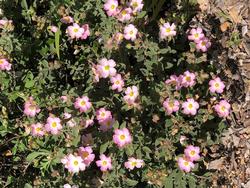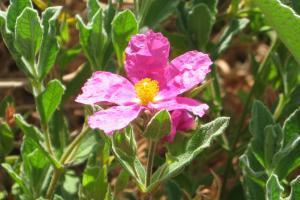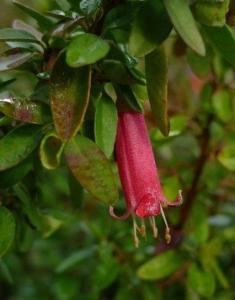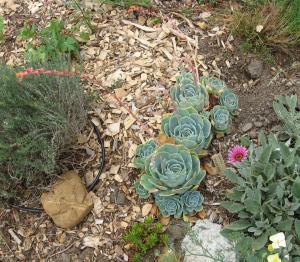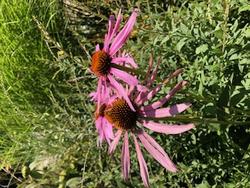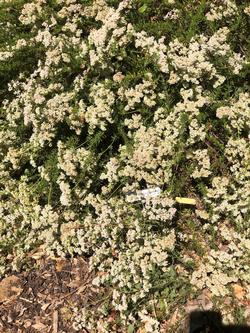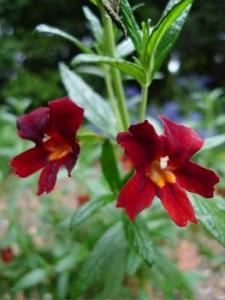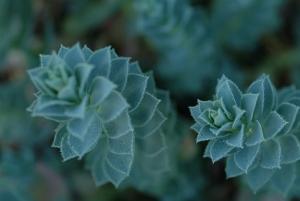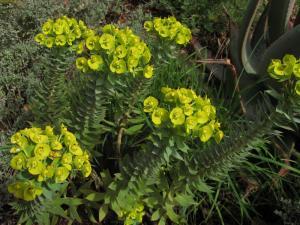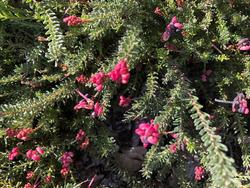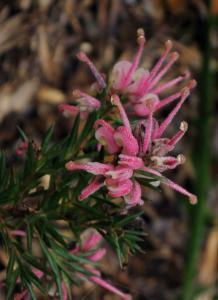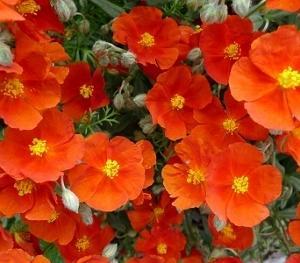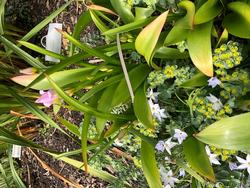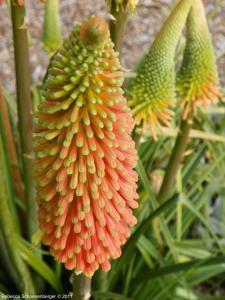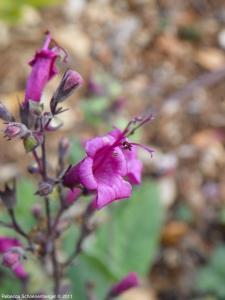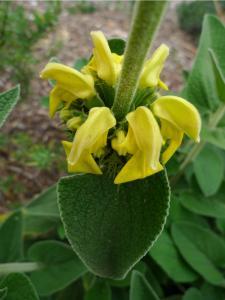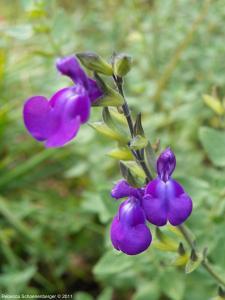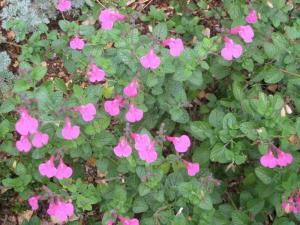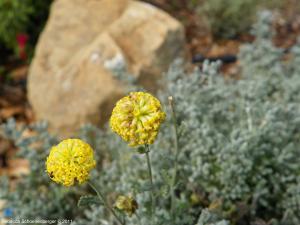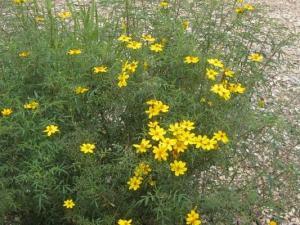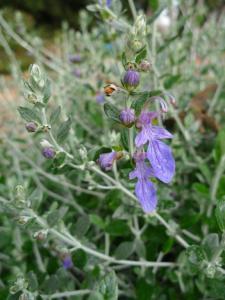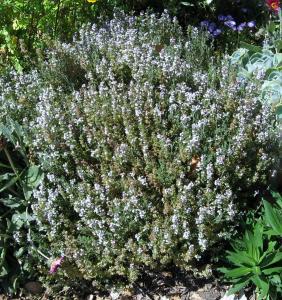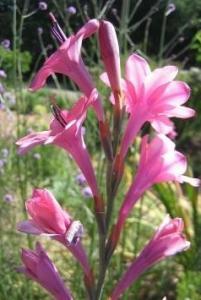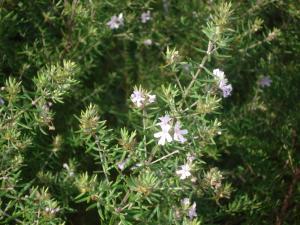Water Wise Plants
Here's a full list of all our water wise plants. You can also view an image gallery, or view the plants by categories.
Aloe striata
Pronunciation
AL-oh stree-AH-tuh
Common Name
Coral Aloe
Plant Type
Succulent
Mature Size
2 ft. to 3 ft. tall and 1 ft. to 2 ft. wide
Water Requirements
Low: water every three weeks until the root ball is wet
Sun/Shade Requirements
Full sun
Wildlife
Flower Color
Red-orange
Where to See
Maintenance- Design- Planting Tips
Like many succulents, Aloes are from South Africa. Aloe striata tolerates cold better than most aloes and grows successfully in the Bay Area. The large, broad, fleshy leaves and tall clusters of flowers are bold additions to the summer-dry perennial bed. As a bonus, hummingbirds and bees are attracted to its orange-red blossoms.
The only maintenance this plant needs is to cut back the inflorescence after the flowers have dropped off. Aloe striata is also easy to propagate. Remove the pups (baby plants) from the base of the plant, let the stems dry and harden, and then plant the cuttings in a pot of cactus soil mix. |
Anemopsis californica
Pronunciation
an-uh-MOP-sis kal-i-FOR-ni-kuh
Common Name
Yerba Mansa
Plant Type
Groundcover
Mature Size
2 wide x 0.33 - 1 ft(0.1 - 0.3 m) tall
Water Requirements
Moderate: water weekly until the root ball is wet
Sun/Shade Requirements
Full to half sun
Wildlife
Flower Color
White, Cream, Red
Where to See
Maintenance- Design- Planting Tips
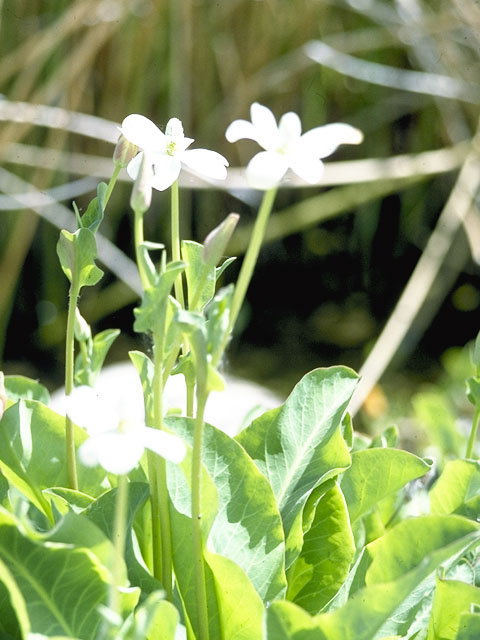
|
Arctotis ‘Purple Torch’
Pronunciation
ark-TOE-tiss
Common Name
African Daisy
Plant Type
Perennial
Mature Size
1 ft. to 1 1/2 ft. tall and wide
Water Requirements
Low: water every three weeks until the root ball is wet
Sun/Shade Requirements
Full sun
Wildlife
Flower Color
Purple
Where to See
Maintenance- Design- Planting Tips
Arctotis ‘Purple Torch’ is a low growing ground cover with gray felty leaves that are attractive even when there are no flowers. It begins blooming in the winter and continues until the weather gets hot. Other varieties of African daisy will bloom through the summer.
To keep Arctotis looking its best, the flowers should be regularly deadheaded when past their prime, and the plant should be replaced every few years. Cuttings root easily in the cool months. PADG notes: The Palo Alto Demonstration garden has planted ‘Purple Torch’ throughout the beds to unify the garden. It combines well with Bulbine frutescens, which blooms at approximately the same time. |
Artemisia douglasiana
Pronunciation
art-ee-MIS-ee-uh dug-las-ee-AH-nuh
Common Name
Douglas' Sagewort
Plant Type
Perennial
Mature Size
4 ft (1.2 m) wide x 8 ft (2.4 m) tall
Water Requirements
Moderate: water weekly until the root ball is wet
Sun/Shade Requirements
Half sun to shade
Wildlife
Flower Color
Cream, White, Yellow
Where to See
Maintenance- Design- Planting Tips
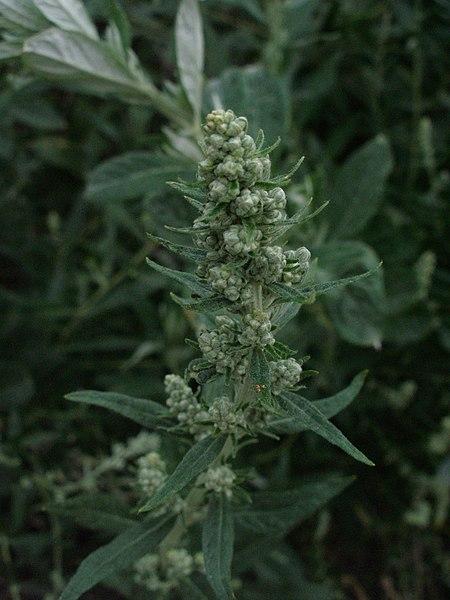
|
Artemisia versicolor ‘Seafoam’
Pronunciation
ar-te-MIZ-ee-uh VER-suh-kuh-lor
Common Name
Artemisia versicolor ‘Seafoam’
Plant Type
Groundcover
Mature Size
6 - 12 in. high can spread 15 - 18 in.
Water Requirements
Low: water every three weeks until the root ball is wet
Sun/Shade Requirements
Full to half sun
Wildlife
Flower Color
Yellow and orange
Where to See
Maintenance- Design- Planting Tips
The leaves of Artemisia ‘Seafoam’ are silver and frilly, which add a nice texture to the garden. It is a short-lived perennial that needs to be replanted after several years. The plant wants to bloom, but unfortunately will die back afterwards. To prevent the die back, cut off the yellow flowers.
PADG notes: ‘Seafoam’ has been used as a small edging plant in the Demonstration Garden. We have repeated silver foliage plants around the edge of the garden beds as a way of tying different beds together. But we find cutting off the flowers to keep the plant looking good to be labor intensive. |
Bearded Iris
Pronunciation
Common Name
Bearded Iris
Plant Type
Bulb
Mature Size
1.5 to 4 feet high Spreads via rhizomes
Water Requirements
Low: water every three weeks until the root ball is wet
Sun/Shade Requirements
Full to half sun
Wildlife
Flower Color
Many colors except true red and green,
Where to See
Maintenance- Design- Planting Tips
Bearded irises are beloved for their showy spring flowers, structurally pleasing upright, green leaves and low, summer water needs. They come in a wide range of colors and shapes. Choosing a mix of early, mid and late bloomers prolongs the spring bloom period, and the addition of re-blooming varieties gives another flush of flowers in the fall and winter season. Unfortunately, re-blooming varieties do need water year-round to re-bloom, and the second bloom has fewer flowers. All bearded irises need full sun for at least half the day to bloom well.
Given enough water from late fall through spring, intermediate bearded iris can grow to a height of 2.5 feet tall, and tall bearded iris can reach 4 feet in height. With enough water they develop tall flower stalks supporting numerous large blooms. With less water during the growing season, the plants are smaller with fewer flowers, but the blooms are still striking. Improve growth by adding compost and mulch in the fall, which helps retain soil moisture and provides nutrients for better bloom. Allow plant leaves and soil to dry out between watering to prevent fungal infections and flower loss. During the summer, bearded irises are dormant, and their leaves die back. For aesthetics many people cut the leaves back when they begin to yellow, but it is not necessary. Plants remain healthy with and without summer trims. Be aware though, there is one major maintenance issue when growing bearded iris. These plants grow from thick rhizomes. Each year new rhizomes spread from the original making a larger clump. As the older rhizomes die, a dead spot will eventually appear in the center of the iris clump. To prevent this from happening and to keep clump size in check, divide iris rhizomes about every three years. Do this during the hot summer months when plants are dormant and fungal infections are less likely to affect the cuts from the mother rhizomes. |
Ceanothus maritimus ‘Valley Violet’
Pronunciation
see-an-OH-thus muh-RIT-tim-mus
Common Name
Maritime ceanothus
Plant Type
Shrub
Mature Size
1'-3' high x 3'-8' wide
Water Requirements
Low: water every three weeks until the root ball is wet
Sun/Shade Requirements
Full sun
Wildlife
Flower Color
Maintenance- Design- Planting Tips
Ceanothus maritimus ‘Valley Violet’ is a California native and a UC Davis Arboretum All-Star. This low growing Ceanothus has a wide spread and can be an effective ground cover. It has dark, blue-green foliage that contrasts nicely with its purple flowers, which bloom from winter into spring. Be aware that all Ceanothus develop buckthorns as they age that can be very sharp.
PADG notes: Several varieties of Ceanothus were planted several years ago in the Native Bed at the Palo Alto Demonstration Garden. As of 2022, Ceanothus maritimus ‘Valley Violet’ is doing the best in the group. It is very drought tolerant and is living up to its All-Star status with the garden’s dry season irrigation cycle. Established plants are watered once every three weeks with drip lines. |
Chrysocephalum apiculatum
Pronunciation
kry-soh-SEE-uh-lum uh-pik-yoo-LAY-tum
Common Name
Silver and Gold Everlasting
Plant Type
Perennial
Mature Size
1' high x 2'-3' wide
Water Requirements
Low: water every three weeks until the root ball is wet
Sun/Shade Requirements
Full sun
Wildlife
Flower Color
Where to See
Maintenance- Design- Planting Tips
Chrysocephalum apiculatum is a low growing perennial strawflower with standout silver foliage and yellow flowers. Like all strawflowers, the fresh spring blooms retain their color as they dry and last on the plant for long periods. When established this is a very drought tolerant plant. It works well near the front of a border but give space for its spread. It should not be planted next to the border’s edge. Trim the flowers when they become unsightly and lightly shape the plant for the next spring bloom. Do not prune heavily.
|
Cistus x argenteus ‘Silver Pink’
Pronunciation
SIS-tus x (ar-JEN-tee-us)
Common Name
Rock Rose
Plant Type
Shrub
Mature Size
2'-3' high x 4'-5' wide
Water Requirements
Low: water every three weeks until the root ball is wet
Sun/Shade Requirements
Full sun
Wildlife
Flower Color
Pink and White
Where to See
Maintenance- Design- Planting Tips
Cistus x argenteus ‘Silver Pink’ has small flowers that densely cover the plant in the spring. At the end of the season the flowers drop off cleanly. This beautiful evergreen shrub naturally grows into a neat, compact mound, with dense, gray-green foliage. It should never be pruned heavily. Like many drought tolerant plants, a heavy pruning can kill it or leave it misshapen. Instead, be sure to allow enough space for the mature shrub in your landscape design so that pruning is not necessary.
|
Cistus x pulverulentus ‘Sunset’
Pronunciation
SIS-tus pul-ver-oo-LEN-tus
Common Name
Rockrose
Plant Type
Shrub
Mature Size
2 ft. tall and 6 - 8 ft. wide
Water Requirements
Low: water every three weeks until the root ball is wet
Sun/Shade Requirements
Full sun
Wildlife
Flower Color
Hot pink
Where to See
Maintenance- Design- Planting Tips
This hot pink rockrose is a long blooming, low growing shrub that can grow to six feet. There are several different rockrose cultivars, with flowers ranging from pink to white to lavender. Rockroses thrive in hot, dry areas. They like well-draining soil and will quickly die if overwatered. The plant can be pruned, but don’t cut into the wood because it may not resprout.
PADG notes: This plant tended to die within two years in the Demonstration Garden’s regularly watered clay soil. The rockrose was planted on a berm (small hill) and received minimal summer water. |
Clematis ligusticifolia
Pronunciation
KLEM-ah-tiss lin-GOOS-tik-uh-fo-lee-a
Common Name
Virgin's Bower
Plant Type
Perennial
Mature Size
2 - 6 in (5 - 15cm) wide x 1 - 30 ft (0.3 - 9.1 m) tall
Water Requirements
Low: water every three weeks until the root ball is wet
Sun/Shade Requirements
Full to half sun
Wildlife
Flower Color
White, Cream
Where to See
Maintenance- Design- Planting Tips
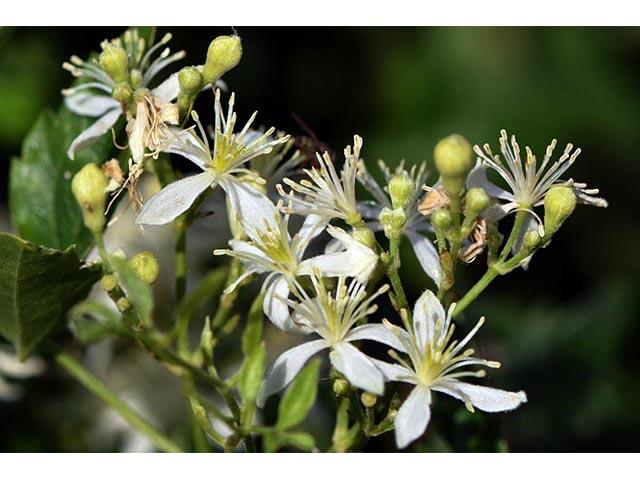
|
Correa ‘Dusky Bells’
Pronunciation
KOR-ree-uh
Common Name
Australian Fuchsia
Plant Type
Shrub
Mature Size
6 ft. to 8 ft. wide and 2 ft. to 3 ft. tall
Water Requirements
Low: water every three weeks until the root ball is wet
Sun/Shade Requirements
Full to half sun, shade
Wildlife
Flower Color
Reddish pink to red, cream, orange, and greenish yellow
Where to See
Maintenance- Design- Planting Tips
Correa has many attributes that make it ideal for Bay Area gardeners. It thrives in sun, partial sun, or shade; is deer resistant and bird friendly; has pretty, long-lasting flowers that provide winter color; does well with moderate to occasional water; does not get too big; tolerates our alkaline soil; and is evergreen.
Also, the shrub requires no deadheading or pruning, so it is practically maintenance-free. Look for some of the newer cultivars of Correa that have been bred to produce more visible flowers above the foliage. |
Echeveria sp.
Pronunciation
ech-eh-ver-EE-a
Common Name
Plant Type
Succulent
Mature Size
Less that 1 ft. tall and wide
Water Requirements
Low: water every three weeks until the root ball is wet
Sun/Shade Requirements
Half sun to shade
Wildlife
Flower Color
Pink, red with yellow tips
Where to See
Maintenance- Design- Planting Tips
Echeveria is a good filler or edging plant for the summer-dry flower border and also does well in pots. The sculptural quality of the fleshy leaves provides a nice contrast to the more delicate leaves of many perennials.
Echeverias are sometimes called ‘Hen and Chicks’, but so are Sempervivums, another succulent. It's one of the problems with using common names. In this case, it is better to use the botanical name, Echeveria. PADG Notes: Echeveria ‘Imbricata’, a UC Davis Arboretum All-Star, is featured in the Demonstration Garden. Some Echeverias do well in full sun, but Imbricata seems to do better in half shade and with a drip very close to the roots. |
Echinacea purpurea
Pronunciation
ek-ih-AY-shee-a pur-PUR-ee-ah
Common Name
Purple cone flower
Plant Type
Perennial
Mature Size
3'-4' high x 2' wide
Water Requirements
Low: water every three weeks until the root ball is wet
Sun/Shade Requirements
Full sun
Wildlife
Flower Color
Purple
Where to See
Maintenance- Design- Planting Tips
Echinacea purpurea is a green-leaved perennial that produces large purple, daisy-like blooms in the summer. It can grow to four feet in height and works well in the background of garden borders. It needs minimal drip irrigation, dies down after bloom, and resprouts in the spring with little extra maintenance required. |
Eriogonum fasciculatum
Pronunciation
er-ih-OG-uh-num fas-sik-yoo-LAH-tum
Common Name
California buckwheat
Plant Type
Shrub
Mature Size
2' high x 4'-5' wide
Water Requirements
Low: water every three weeks until the root ball is wet
Sun/Shade Requirements
Full sun
Wildlife
Flower Color
Maintenance- Design- Planting Tips
Eriogonum fasciculatum is a drought-tolerant California native shrub. Reaching only two feet in height with a four-to-five-foot spread, it is a good mid-border choice. The shrub has many branches that are densely covered with small, dark green, needle-like leaves and is covered with pinkish-white clusters of tiny flowers in spring which turn an attractive rust color in summer and fall. When not flowering, it is an attractive contrast to other plants in the mixed border. Trim flowers off when they become unsightly and lightly shape the plant. Do not prune heavily.
|
Erythranthe guttata
Pronunciation
er-EE-thranthe goo-TA-ta
Common Name
Monkey Flower
Plant Type
Perennial
Mature Size
2 1/2 ft. tall and wide
Water Requirements
Low: water every three weeks until the root ball is wet
Sun/Shade Requirements
Full to half sun, shade
Wildlife
Flower Color
White, cream, yellow, orange, copper, salmon, red, maroon
Where to See
Maintenance- Design- Planting Tips
Mimulus is a cheerful California native that adds bright color to the garden. This shrubby perennial has been hybridized heavily to produce a rainbow of colors. In the wild, different species of Mimulus can be found from southern Oregon to southern California.
Happy in sun or part shade, these plants prefer good drainage. With supplemental water, you can expect some repeat bloom all summer. Mimulus is a favorite in native plant gardens because of its color range. When new foliage appears at its base in late winter, the plant is ready to be pruned back to the new green growth. This hard pruning will rejuvenate the plant. If there is no growth at the base, then gently pinch the tips to encourage new growth. The scientific name of this plant was recently changed from Mimulus guttatus to Erythranthe guttata. PADG notes: Some Master Gardeners have found this plant to be short-lived; other Master Gardeners have Mimulus plants in their personal gardens that are over five years old and doing just fine. These plants are easy to propagate from cuttings and seeds. |
Euphorbia myrsinites
Pronunciation
yew-FOR-bee-ah mur-zin-EYE-teez
Common Name
Creeping Spurge
Plant Type
Groundcover
Mature Size
6 - 12 in. tall and 12 in. wide
Water Requirements
Low: water every three weeks until the root ball is wet
Sun/Shade Requirements
Full to half sun
Wildlife
Flower Color
Yellow
Where to See
Maintenance- Design- Planting Tips
With its eye catching texture and showy flowers in the spring, Euphorbia myrsinites makes an attractive ground cover for dry areas. These plants will reseed vigorously if not deadheaded, so be sure to cut off the flowering stalks before seeds develop. Leave new growth intact since that will be next spring's flowers.
Take care when cutting Euphorbias because the milky sap can be very irritating to the skin. |
Euphorbia rigida
Pronunciation
yew-FOR-bee-ah RIH-jih-dah
Common Name
Euphorbia
Plant Type
Perennial
Mature Size
3 ft. to 4 ft. high and wide
Water Requirements
Low: water every three weeks until the root ball is wet
Sun/Shade Requirements
Full to half sun
Wildlife
Flower Color
Where to See
Maintenance- Design- Planting Tips
Hundreds of varieties of Euphorbias are available ranging from groundcovers to shrubs. These Mediterranean perennials are hardy plants. Chartreuse or lime green flowers appear in late winter and hold well through spring. Euphorbias are very showy in the winter garden and continue looking good during the hot summer.
Euphorbias can be aggressive reseeders so cut off the flower stalks at the base sometime in May before they set seed. Be careful of the sap as it may irritate the skin. |
Grevillea lanigera ‘Coastal Gem’
Pronunciation
grev-ILL-ee-uh lan-EE-ger-ruh
Common Name
Wooley Grevillea
Plant Type
Shrub
Mature Size
1'-1.5' high x 4'-5' wide
Water Requirements
Low: water every three weeks until the root ball is wet
Sun/Shade Requirements
Full to half sun
Wildlife
Flower Color
Where to See
Maintenance- Design- Planting Tips
Grevillea lanigera ‘Coastal Gem’ is covered with showy pink flowers from fall into spring, providing color when most plants do not bloom. Plan the garden so the remaining spring blossoms accent the early spring blooms on other plants. When not in bloom, this is a compact and attractive shrub with gray-green leaves. It is very drought tolerant once established.
|
Grevillea rosmarinifolia
Pronunciation
grah-VIL-ee-ah rose-ma-ree-nee-FOH-lee-uh
Common Name
Grevillea
Plant Type
Shrub
Mature Size
3 ft. high and 6 ft. wide
Water Requirements
Low: water every three weeks until the root ball is wet
Sun/Shade Requirements
Full to half sun
Wildlife
Flower Color
Red and cream
Where to See
Maintenance- Design- Planting Tips
Grevillea is a no fail plant. It's tough, deer resistant, loved by hummingbirds, and a fall to spring bloomer.
The Grevillea pictured is a dwarf form of Grevillea rosmarinifolia. It has evergreen rosemary-like leaves and stays about 3 feet high by 6 feet wide. It flowers in the winter when not much is blooming and provides a tidy, low growing shrub in the summer when other plants take center stage. Grevillea does well with a deep watering once every three weeks. It also grows well in gardens that get regular water. Be careful of using fertilizer with phosphorus around Grevillea. No maintenance, deadheading, or trimming back is required for this plant. Note that there are over 250 species and hybrids of Grevillea. Some have fine leaves; others have courser leaves. Some make great ground covers; others grow to be the size of the small trees. Some tolerate cold weather better than others. Research cultivars carefully before selecting plants. |
Grindelia hirsutula
Pronunciation
grin-DELL-ee-a hir-SU-too-la
Common Name
Great Valley Gumweed
Plant Type
Perennial
Mature Size
3 ft. wide x 2 - 6.6 ft (0.6 - 2 m) tall
Water Requirements
Very Low: water deeply several times a summer
Sun/Shade Requirements
Full sun
Wildlife
Flower Color
Yellow
Where to See
Maintenance- Design- Planting Tips
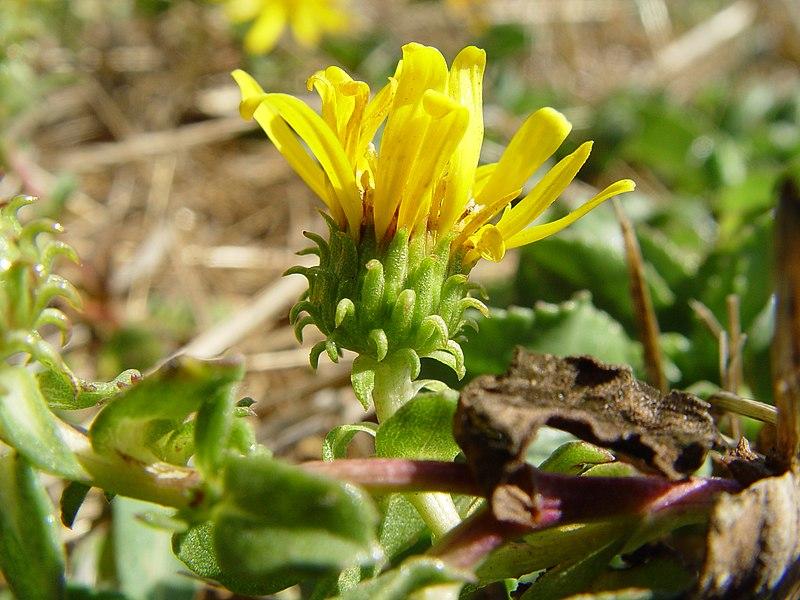
|
Helianthemum nummularium ‘Henfield Brilliant’
Pronunciation
hee-lee-AN-them-um num-ew-LAH-ree-um
Common Name
Sunrose
Plant Type
Groundcover
Mature Size
6 in. to 12 in. high and 18 in. to 3 ft. wide
Water Requirements
Low: water every three weeks until the root ball is wet
Sun/Shade Requirements
Full to half sun
Wildlife
Flower Color
Orange-red
Where to See
Maintenance- Design- Planting Tips
A low-growing, trailing ground cover from Turkey, Helianthemum is covered with small flowers in the spring. There are many cultivars with different flower colors — red, apricot, yellow, pink, and white. ‘Henfield Brilliant’ is a striking form with its silvery leaves and orange flowers.
Helianthemum likes full sun and well-draining soil with low to moderate water. Shear off the dead flowers to encourage repeat blooms. |
Ipheion uniflorum
Pronunciation
IF-ee-on yoo-nee-FLOR-um
Common Name
Starflower
Plant Type
Bulb
Mature Size
0.5' high x Spreads
Water Requirements
Moderate: water weekly until the root ball is wet
Sun/Shade Requirements
Full to half sun
Wildlife
Flower Color
Where to See
Maintenance- Design- Planting Tips
Ipheion uniflorum has low-growing green leaves and is covered with white star-shaped flowers in early spring. It dies down to the bulb after bloom and resprouts when fall and winter rains begin. It is a dainty and beautiful addition to garden edge. It reliably complements the early blooming narcissus and other spring flowers and requires little maintenance other than extra water if it does not rain during bloom.
|
Kniphofia
Pronunciation
ny-FOE-fee-ah
Common Name
Red Hot Poker
Plant Type
Perennial
Mature Size
Varies by cultivar
Water Requirements
Low: water every three weeks until the root ball is wet
Sun/Shade Requirements
Full to half sun
Wildlife
Flower Color
Red, orange, yellow, near white
Where to See
Maintenance- Design- Planting Tips
The glowing torch-like flowers spikes of Kniphofia are reliable midsummer bloomers and provide great vertical accents. Many sizes and colors of Kniphofias have been developed, including reds, oranges, yellows, and near whites. The flower colors can be dramatic and intense, so take care in selecting flower colors that blend well with your plants.
Deadhead the plants when the old flower spikes become unattractive. When the leaves start looking shabby in the winter, cut the foliage back about three inches above the ground. Kniphofia will come back beautifully in the spring. The plant divides easily but it doesn't seem to require dividing to stay vigorous. PADG notes: The Palo Alto Demonstration Garden has several Kniphofias including ‘Christmas Cheer', which is a UC Davis Arboretum All-Star. It has brilliant orange buds that open to a deep-gold tubular flower. ‘Christmas Cheer’ blooms in the fall and winter unlike many other Kniphofias. |
Lepechinia hastata
Pronunciation
le-peh-KIN-ee-uh hass-TAH-tuh
Common Name
Pitcher Sage
Plant Type
Shrub
Mature Size
3 ft. tall and wide in low water gardens
Water Requirements
Very Low: water deeply several times a summer
Sun/Shade Requirements
Full to half sun
Wildlife
Flower Color
Magenta
Where to See
Maintenance- Design- Planting Tips
Pitcher sage is an aromatic member of the mint family that is attractive in wild gardens. In late summer these plants have reddish purple flowers on medium-sized spikes. Hummingbirds and bees love them, so they add quite a bit of life to a garden. Another feature is the plant’s large leaves, which offer a nice contrast to many plants from the Mediterranean region that have smaller foliage. Although some pitcher sages are native to California, Lepechinia hastata is from Mexico.
PADG notes: Some reference books say this plant can get up to 6 feet tall, but in the Palo Alto Demonstration Garden, they have stayed a modest 3 feet tall and wide. The trick may be not to overwater them. |
Maianthemum stellatum
Pronunciation
mie-ANTH-uh-moom stel-AH-toom
Common Name
False Solomon Seal
Plant Type
Perennial
Mature Size
1 - 2 ft. (0.3 - 0.6 m) wide x 2.5 ft.(0.8 m) tall
Water Requirements
Low: water every three weeks until the root ball is wet
Sun/Shade Requirements
Shade
Wildlife
Flower Color
White, Red
Where to See
Maintenance- Design- Planting Tips
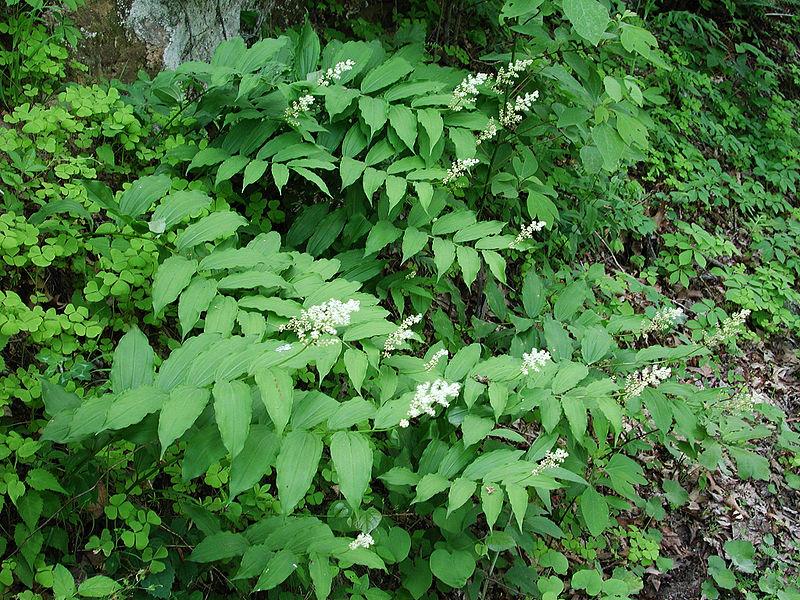
|
Phlomis fruticosa
Pronunciation
FLOW-miss fru-tih-KOE-sah
Common Name
Jerusalem Sage
Plant Type
Shrub
Mature Size
4 ft. tall and wide
Water Requirements
Low: water every three weeks until the root ball is wet
Sun/Shade Requirements
Full sun
Wildlife
Flower Color
Where to See
Maintenance- Design- Planting Tips
From the Mediterranean Basin, this sun-loving shrub has unique yellow ball-shaped flowers. The large wooly-gray leaves are a good texture complement to other water-wise plants, many of which have small-leaves to conserve water.
Occasional water will encourage repeat blooms. However, Phlomis fruticosa will tolerate very dry conditions. This plant can be cut back by half in the fall to keep it compact. Some Master Gardeners are a little more daring and like to cut Phlomis back to six inches above the ground. This will keep the plant even more compact. Another option is to do nothing at all if the size and woodiness of the plant are not an issue. |
Salvia Hybrid 'Christine Yeo'
Pronunciation
SAL-vee-uh
Common Name
Sage 'Christine Yeo'
Plant Type
Perennial
Mature Size
12-18 in. high and 24 - 36 in. wide
Water Requirements
Low: water every three weeks until the root ball is wet
Sun/Shade Requirements
Full to half sun, shade
Wildlife
Flower Color
Where to See
Maintenance- Design- Planting Tips
Salvias microphyllas is a shrubby perennial that come in a wide variety of colors and will bloom many months with deadheading. It stays a manageable size in the garden and will not overwhelm neighboring plants.
The flower pictured here is Salvia hybrid 'Cristine Yeo'. It is a cross between Salvia microphylla and Salvia chamaedryoides. PADG Notes: Salvia microphyllas prefer full sun, but this plant is doing well with morning sun and afternoon shade in our garden. It seems a little floppy, which might be a shade issue or just its natural form. With a little work, the Salvia microphyllas can be kept in top form in your garden. At PADG, all flowers are sheared off in early summer and again during fall clean up. This keeps the plant more compact and encourages repeat blooming. In the spring, one third of is oldest stems are pruned out to keep the plant from getting woody. A nice bonus for pruning work -- the leaves of these Salvias smell wonderful. |
Salvia microphylla 'UCB Pink'
Pronunciation
SAL-vee-uh My-kro-FIL-uh
Common Name
Sage 'UCB Pink'
Plant Type
Perennial
Mature Size
3 ft. to 4 ft. wide and tall
Water Requirements
Low: water every three weeks until the root ball is wet
Sun/Shade Requirements
Full sun
Wildlife
Flower Color
Maintenance- Design- Planting Tips
This hot pink Salvia blooms in late fall when few other plants are blooming. In general Saliva microphylla plants do well in summer-dry perennial gardens and don't need a great deal of maintenance.
PADG Notes: 'UCB Pink' seems to bloom more consistently than many of the Salvia microphylla types. In the fall, the skinny branches of this plant are sheared off to form a neat ball. Avoid cutting into the thicker woody stems because it could affect regrowth. Regular pruning keeps this plant fuller and encourages more flowering the next season. If you want to learn more about Salvias, we suggest reading Betsy Clebsch's book called The New Book of Salvias. |
Santolina chamaecyparissus 'Nana'
Pronunciation
san-toh-LEE-nuh kam-ee-ky-par-ISS-us
Common Name
Dwarf Lavender Cotton
Plant Type
Perennial
Mature Size
2 ft. tall and 3 ft. wide
Water Requirements
Very Low: water deeply several times a summer
Sun/Shade Requirements
Full to half sun
Wildlife
Flower Color
Where to See
Maintenance- Design- Planting Tips
Santolina chamaecyparissus 'Nana' is a compact shrub with silver grey foliage and bright yellow flowers. This cultivar is very slow growing and stays a nice size.
PADG Notes: We originally had a full sized Santolina, but the plant fell apart when it bloomed. It was unattractive, so it was removed it from the garden. Santolina chamaecyparissus 'Nana' is a good choice for an edger or in a knot garden because it doesn't require the pruning that the larger species needs. We've used short silver plants as edging throughout the Demonstration Garden to tie the garden together visually. |
Scrophularia californica
Pronunciation
skrof-ew-LAH-ree-uh kal-i-FOR-ni-kuh
Common Name
California Bee Plant
Plant Type
Perennial
Mature Size
6 - 12 in (15 - 30cm) wide x 2 - 4 ft (0.6 - 1.2 m) tall
Water Requirements
Low: water every three weeks until the root ball is wet
Sun/Shade Requirements
Half sun
Wildlife
Flower Color
Red
Where to See
Maintenance- Design- Planting Tips
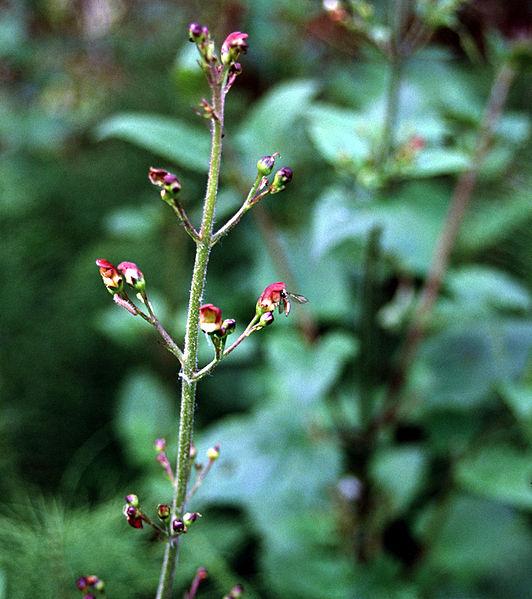
|
Symphyotrichum chilense
Pronunciation
sim-fee-OT-ri-koom chi-LEN-see
Common Name
California Aster (Pacifc Aster)
Plant Type
Perennial
Mature Size
3 ft (0.9 m) wide x 1.3 - 3.3 ft. (0.4 - 1 m) tall
Water Requirements
Low: water every three weeks until the root ball is wet
Sun/Shade Requirements
Full to half sun
Wildlife
Flower Color
Blue, Lavender, Yellow
Where to See
Maintenance- Design- Planting Tips
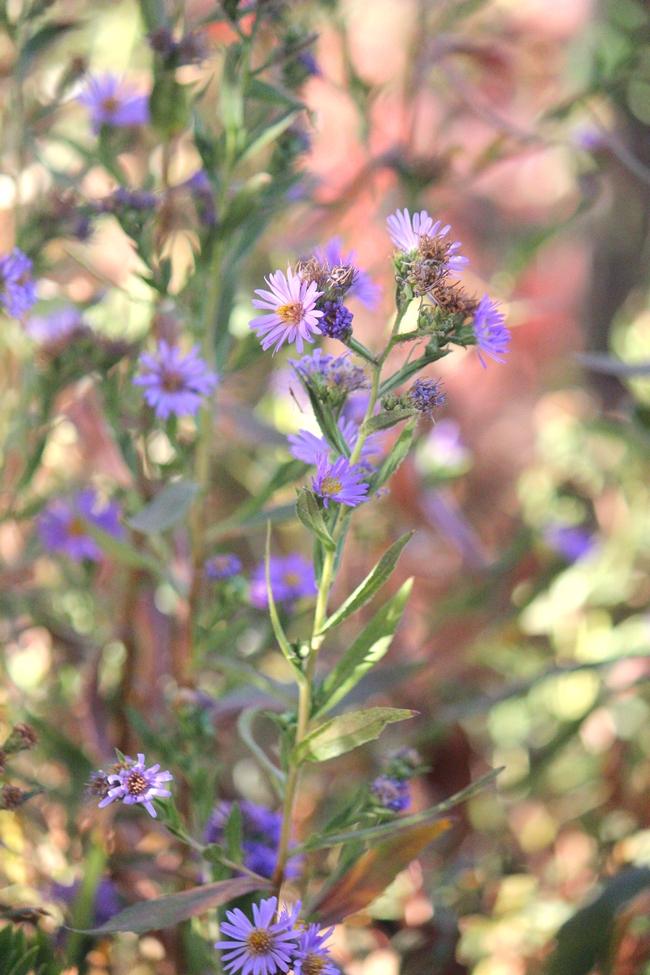
|
Tagetes lemmonii
Pronunciation
tah-JEE-deez lem-mon-ee-eye
Common Name
Mexican Bush Marigold
Plant Type
Perennial
Mature Size
4 ft. to 6 ft. wide and 3 ft. to 6 ft. tall
Water Requirements
Low: water every three weeks until the root ball is wet
Sun/Shade Requirements
Full to half sun
Wildlife
Flower Color
Where to See
Maintenance- Design- Planting Tips
Tagetes lemmonii is a sprawling shrub-like perennial with yellow flowers and aromatic leaves. The plant is originally from Mexico and the southwestern U.S.
PADG Notes: Mexican Bush Marigold can become large and ungainly, so we recommend shearing this plant several inches from the ground in the spring to keep the plant compact and give it a nice shape. Also, prune out any frost damage once the danger of frost is over. Tagetes lemmonii is not long-lived in the garden, but if you like yellow flowers and enjoy the smell of its leaves this plant is worth planting. In the demonstration garden we removed Tagetes lemmonii because it repeatedly suffered frost damage and was not attractive. |
Teucrium fruticans ‘Azureum’
Pronunciation
Tew-kree-um FREW-ti-kanz
Common Name
Bush Germander
Plant Type
Shrub
Mature Size
4 - 6 ft. tall and wide
Water Requirements
Low: water every three weeks until the root ball is wet
Sun/Shade Requirements
Full sun
Wildlife
Flower Color
Violet blue
Where to See
Maintenance- Design- Planting Tips
Teucium fruticans 'Azureum' has attractive blue flowers all winter long. The rest of the year it has a smaller floral display. The deep blue stands out against the grey foliage.
PADG Notes: A drawback to Bush Germander is it can grow to be very large. We pruned ours back to 4 inches to help control its size. The shrub came roaring back with a natural shape and a slightly smaller size. The winter blooms are plentiful. We recently planted a smaller Teucrium cultivar, 'Compactum' that is reputed to stay 3 feet tall and wide and have intense blue flowers. |
Thalictrum fendleri var. polycarpum
Pronunciation
thuh-LIK-troom fend-LAH-ree
Common Name
Meadow Rue
Plant Type
Perennial
Mature Size
2 ft (0.6 m) wide x 2 - 4 ft (0.6 - 1.2 m) tall
Water Requirements
Moderate: water weekly until the root ball is wet
Sun/Shade Requirements
Half sun
Wildlife
Flower Color
Cream, Green, Yellow
Where to See
Maintenance- Design- Planting Tips
Meadow Rue is used in woodland and shade gardens as a perennial background plant. It has beautiful lacy blue-green foliage that unfurls from purplish shoots. The tiny unisexual flowers are produced atop 2 - 4 ft. tall stalks on separate plants. The male flowers are showier with dangling cream-yellow colored stamens; the female flowers are clusters of greenish pistils. It goes dormant in late summer when it is allowed to go dry. This Meadow Rue is easy to grow, in part sun to shade. It grows with occasional to regular irrigation, and can be drought-tolerant once established. |
Thymus vulgaris
Pronunciation
TY-mus vul-GAR-iss
Common Name
Thyme
Plant Type
Groundcover
Mature Size
3 in. high and 3 ft. wide
Water Requirements
Low: water every three weeks until the root ball is wet
Sun/Shade Requirements
Full to half sun
Wildlife
Flower Color
Where to See
Maintenance- Design- Planting Tips
Many herbs, including thyme, are great additions to water wise gardens. They can be used in cooking; they smell great and their foliage and flowers are attractive.
Thyme makes a nice ground cover for small spaces. It has grey-green leaves and small white flowers. PADG Notes: To keep thyme neat, the faded flowers are sheared back in early spring. Many thymes are not long lived, but Thymus vulgaris has proven to be long-lived in our water wise garden. |
Watsonia
Pronunciation
wat-SON-ee-uh
Common Name
Watsonia
Plant Type
Bulb
Mature Size
2 1/2 ft. tall and wide
Water Requirements
Low: water every three weeks until the root ball is wet
Sun/Shade Requirements
Full sun
Wildlife
Flower Color
Pink, rosy red, white, lavender, peach, orange
Where to See
Maintenance- Design- Planting Tips
Watsonia is a South African plant that grows well in the Santa Clara Valley. The pink gladiolus-like flowers are a highlight of late spring gardens. The sword-shaped leaves provide strong accent points in beds. Some retail nurseries carry a selection of Watsonia corms (bulbs) in the fall.
PADG Notes: This is a summer dormant plant, which means it can get by on almost no water in the summer but has unattractive leaves starting in July. We solve the ugly leaf problem by cutting the leaves back to a couple inches above ground in mid-summer. This results in a bare spot in the bed. If that bothers you, install a plant next to the Watsonia that will fill in the bare spot during the summer and fall months. |
Westringia fruticosa 'Wynyabbie Gem"
Pronunciation
west-RING-ee-uh froo-tih-KOH-suh
Common Name
Coast Rosemary
Plant Type
Shrub
Mature Size
3 - 6 ft. tall and 5 - 10 ft. wide
Water Requirements
Low: water every three weeks until the root ball is wet
Sun/Shade Requirements
Full sun
Wildlife
Flower Color
White to light lavender
Where to See
Maintenance- Design- Planting Tips
This shrub from Australia looks a lot like rosemary, but its leaves are finer and have no fragrance. It has light lavender flowers that appear in midwinter and last through spring.
Westringia grow into large plants so plan ahead or be prepared for a lot of pruning. Unlike rosemary, the stems of Westringia do not get woody, which makes it is a better long term landscaping choice. |







